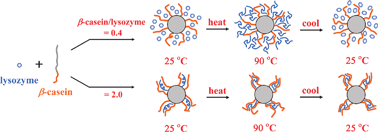Unfolding and refolding details of lysozyme in the presence of β-casein micelles
Abstract
In this work, we selected a small globular

* Corresponding authors
a
Key Laboratory of Bioorganic Phosphorous Chemistry and Chemical Biology (Ministry of Education), Department of Chemistry, Tsinghua University, Beijing 100084, P. R. China
E-mail:
yuzhw@tsinghua.edu.cn
Fax: +86 10 6277 1149
Tel: +86 10 6279 2492
In this work, we selected a small globular

 Please wait while we load your content...
Something went wrong. Try again?
Please wait while we load your content...
Something went wrong. Try again?
F. Wu, J. Luo and Z. Yu, Phys. Chem. Chem. Phys., 2011, 13, 3429 DOI: 10.1039/C0CP01184C
To request permission to reproduce material from this article, please go to the Copyright Clearance Center request page.
If you are an author contributing to an RSC publication, you do not need to request permission provided correct acknowledgement is given.
If you are the author of this article, you do not need to request permission to reproduce figures and diagrams provided correct acknowledgement is given. If you want to reproduce the whole article in a third-party publication (excluding your thesis/dissertation for which permission is not required) please go to the Copyright Clearance Center request page.
Read more about how to correctly acknowledge RSC content.
 Fetching data from CrossRef.
Fetching data from CrossRef.
This may take some time to load.
Loading related content
